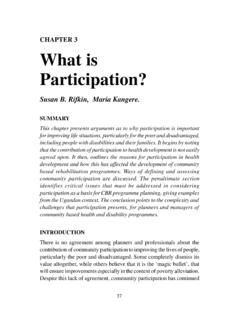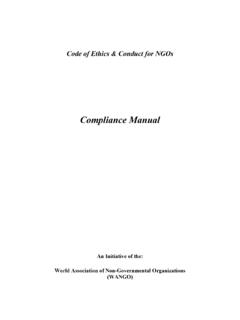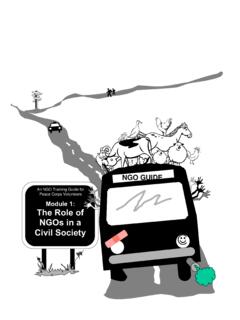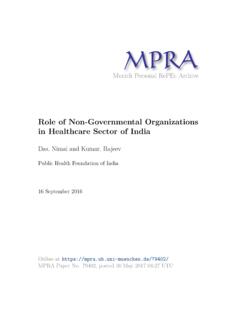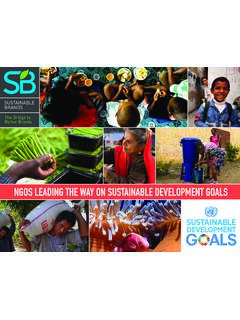Transcription of CHAPTER 11 The Role of Local NGOs in Promoting ...
1 137 THE role of Local ngos IN Promoting PARTICIPATIONCHAPTER 11 The role of LocalNGOs in PromotingParticipation in CBRB asil Kandyomunda, Servious Dube,Maria Kangere, Mekdes CHAPTER considers the three different types of ngos working withpeople with disabilities (PWDs), namely, organisations of people withdisabilities, associations of parents of children with disabilities andorganisations for PWDs. The CHAPTER highlights the role that NGOshave played in pioneering the development of CBR services and theirpotential capacity, to facilitate partnerships between the stakeholdergroups. It gives specific examples of NGO activities in Ethiopia, Ugandaand Zimbabwe, noting the relationship between their successes, the typeof NGO and the necessity for complementary participation of allstakeholders. It suggests that ngos strengths lie in their potentialcapacity to be flexible and to participate and respond to the peoples real needs, particularly vulnerable groups in remote locations.
2 NGOshave skills in the development of a people centred agenda and haveaccumulated experiences in lobbying, sensitisation, informationdissemination and advocacy. Challenges faced by ngos are alsoexamined, with a view to improving their capacity to form partnershipsthat will maximise the effectiveness of CBR A PARTICIPATORY STRATEGY IN AFRICAINTRODUCTIONIt is recognised that ngos have played a significant role in thedevelopment of rehabilitation services for persons with disabilitiesworldwide. This has been done regularly in the absence of Governmentinvolvement and initially took an institutional, charity-based day developments, however, favour a participatory, community-based approach, complementing and liaising with Government plansand services, and working with all the stakeholders groups.
3 ngos andGovernments vary in their capacity to change their working practices toachieve these factor which influences the capacity of disability related ngos tomake the necessary changes, appears to relate to their different forms,which range from small community based to national or internationalorganisations (Lang, 2000). Local ngos can be considered as indigenoushumanitarian organisations and associations established by localcommunity members, Local professionals or a combination of the area of disability, the challenge is whether Local ngos have thequalities that can effectively influence power and move resources infavour of PWDs and CBR OF Local ngos WORKING IN THE AREAOF DISABILITYThe types of Local ngos can broadly be divided into three andcategorised by the nature of the initiators who established them.
4 Theyare listed below, in the order of their historical development. Theseorganisations, even the small and locally based ones, usually get mostof their financial support from international organisations. Theinternational ngos range from multilateral, to bilateral funding agenciessuch as OXFAM and World Vision (Lang, 2000), and usually have aninternational role of Local ngos IN Promoting PARTICIPATION1. Organisations for persons with disabilitiesOrganisations for persons with disabilities have been on the scene for thelongest period of time, and were generally set up by philanthropists. Theytended to be focused on specific impairment groups and were charity ormedically based. Their membership often has a common denominatorsuch as: Local community members living in the same geographical areassuch as traditional organisations.
5 Religious organisations/associations. Professional Organisations of people with disabilities (PWDs)Organisations of people with disabilities were also established on thepremise of uni-disability, for example, organisations dealing with theblind, the deaf. In the countries where the authors have had experience,these different organisations of persons with disabilities, joined to form anational umbrella organisation such as National Union of DisabledPersons of Uganda (NUDIPU), Ethiopian Federation of Persons withDisability (EFPD) and National Council of Disabled People of Zimbabwe(NCDPZ). The emergence of organisations of persons with disabilities,is a relatively new development that is timely and in line with a slogan of, nothing about us without us .3. Associations of the parents of children with disabilitiesThe organisations/associations of the parents of children with disabilitieshave emerged largely as a consequence of CBR.
6 They are recognised aspivotal organisations looking into issues affecting children withdisabilities. These organisations were formed as a felt need, becauseparents of children with disabilities organisations, neither fitted intoorganisations of PWDs, or those for persons with wide range of interests and perceptions reflected in the membershipof these three types of disability related ngos , is apparent from the140 CBR A PARTICIPATORY STRATEGY IN AFRICA different activities in which they are engaged. These vary from institutionalcare, to educational projects, to financial support. Recent developments,have embraced a more socially orientated focus on participation, advocacyand OF DISABILITY ngos INPROMOTING PARTICIPATION AND CBR PROGRAMMESMany people argue and debate as to what is the best role for ngos inproviding services and support for disabled people and their their role been effective so far?
7 Should it remain the same? Shouldit change now, is this the right time? Is their role one of promotingparticipation, of assisting disabled people to be heard by planners andpoliticians? Or, is it providing services that the Government cannot ordoes not provide? ngos have grown in numbers over the past years and also widenedtheir scope of work in all aspects of human need. This has influencedthe status quo in favour of a people centred approach to development(Bennett, 1997). In turn, this has encouraged greater participation ofPWDs and their families, which has led to an increased understanding ofthe ways in which disabled people are excluded and segregated frommainstream society. As a direct result, more rights and advocacy based activities have developed. The issue now, therefore, is how best can localNGOs promote positive attitudes and foster positive attitudinal change?
8 It is this change of attitude that will liberate PWDs and enable them toactively participate and indeed, own have a propensity to work in small locations, achieving impact onthe ground, as compared to the Government services that usually addressthe needs of a majority with little attention given to members of the civilsociety, who have no groups such as women, children and people with disabilities,have always needed support from the voluntary sector to articulate (1991) highlights the role that the voluntary sector plays inmainstream development, as follows:141 THE role of Local ngos IN Promoting PARTICIPATION Encouraging official aid and government ministries to adoptsuccessful approaches to development. Educating and sensitising the public, as to their rights andentitlements. Attuning official programmes to public needs, through acting as aconduit for public opinions and Local experience.
9 Influencing Local development policies of national and internationalinstitutions. Provider of alternative services and development ngos have endeavoured to fill up gaps left by Governments inpromoting participation of the identified stakeholders; to redress issuesof access to community based rehabilitation services for people withdisabilities, through various strategies that may include: Resource mobilisation; Community mobilisation and sensitisation; Community education and training; Attitude and behaviour change; Capacity building; Mechanisms for social economic empowerment; Research and information dissemination; Networking, lobbying and participating in these various ways, Local ngos have played a linkingrole between the grassroots and international organisations, which havefostered the development of CBR in OF FACILITATING PARTNERSHIP BETWEENSTAKEHOLDERSIn Africa, families, charities, non-Government organisations, community-based organisations and the government, have made a significant142 CBR A PARTICIPATORY STRATEGY IN AFRICA contribution in the rehabilitation of people with disabilities, in thecommunity.
10 CBR, which started as a concept twenty years ago, is nowlooked at as a strategy that promotes partnership and collaborationbetween various groups (Boyce & Johnston, 1998; WHO/UNESCO/ILO, 1994). But, what does this mean within the context of CBR inAfrica? In what ways would Local ngos participate? Which NGOswould want to participate? How would they participate and how couldone quantify participation of ngos , parents, and persons withdisabilities, communities and government?In the promotion of participation, participants were stimulated to analysewhy there was a need to first find out, what participation as a conceptmeant in the context of CBR in Africa. In what ways would Local ngos participation take place? Which ngos would want to participate? Inwhat ways would one quantify participation of ngos , parents, andpersons with disabilities, communities and government?
